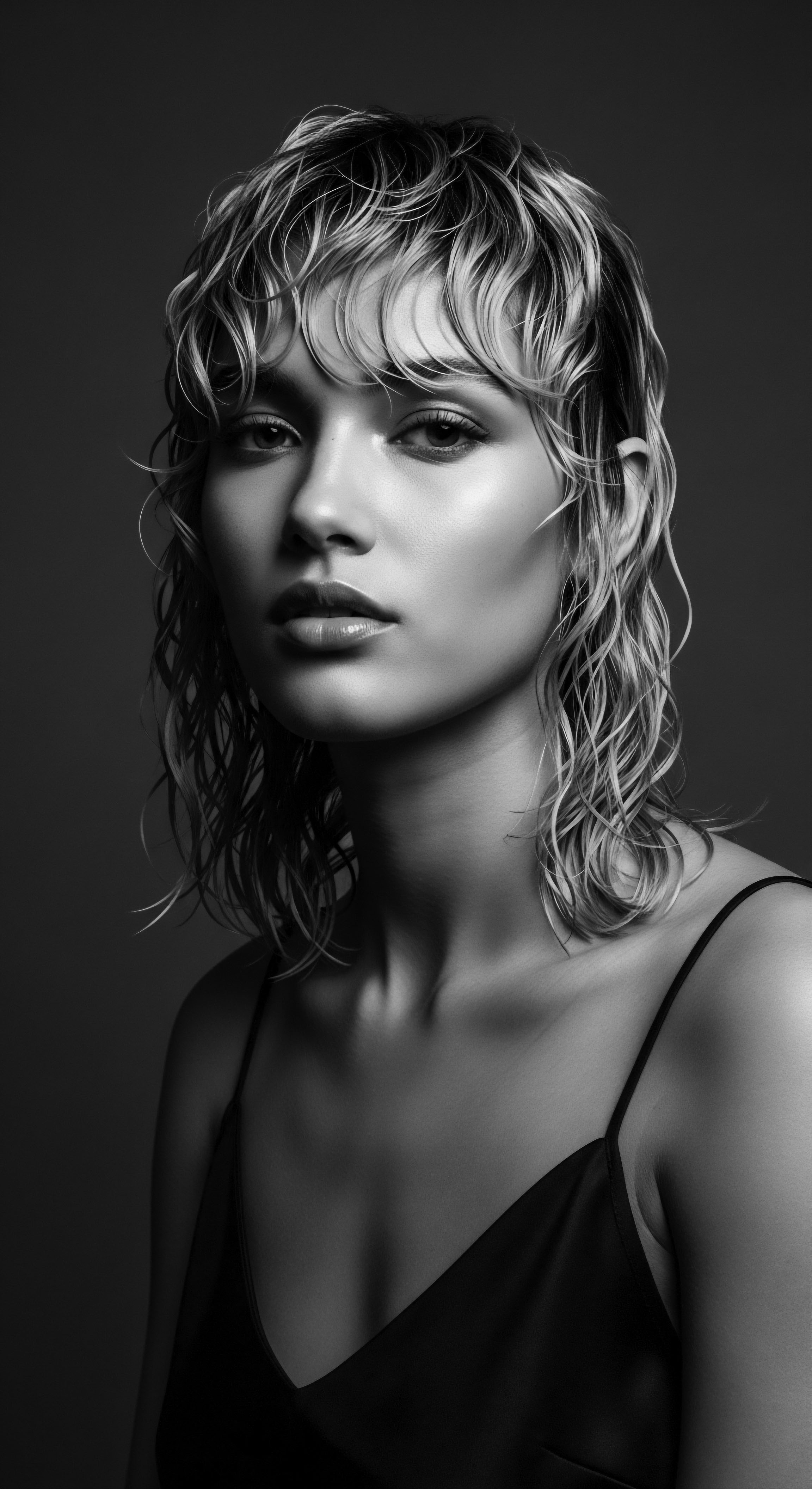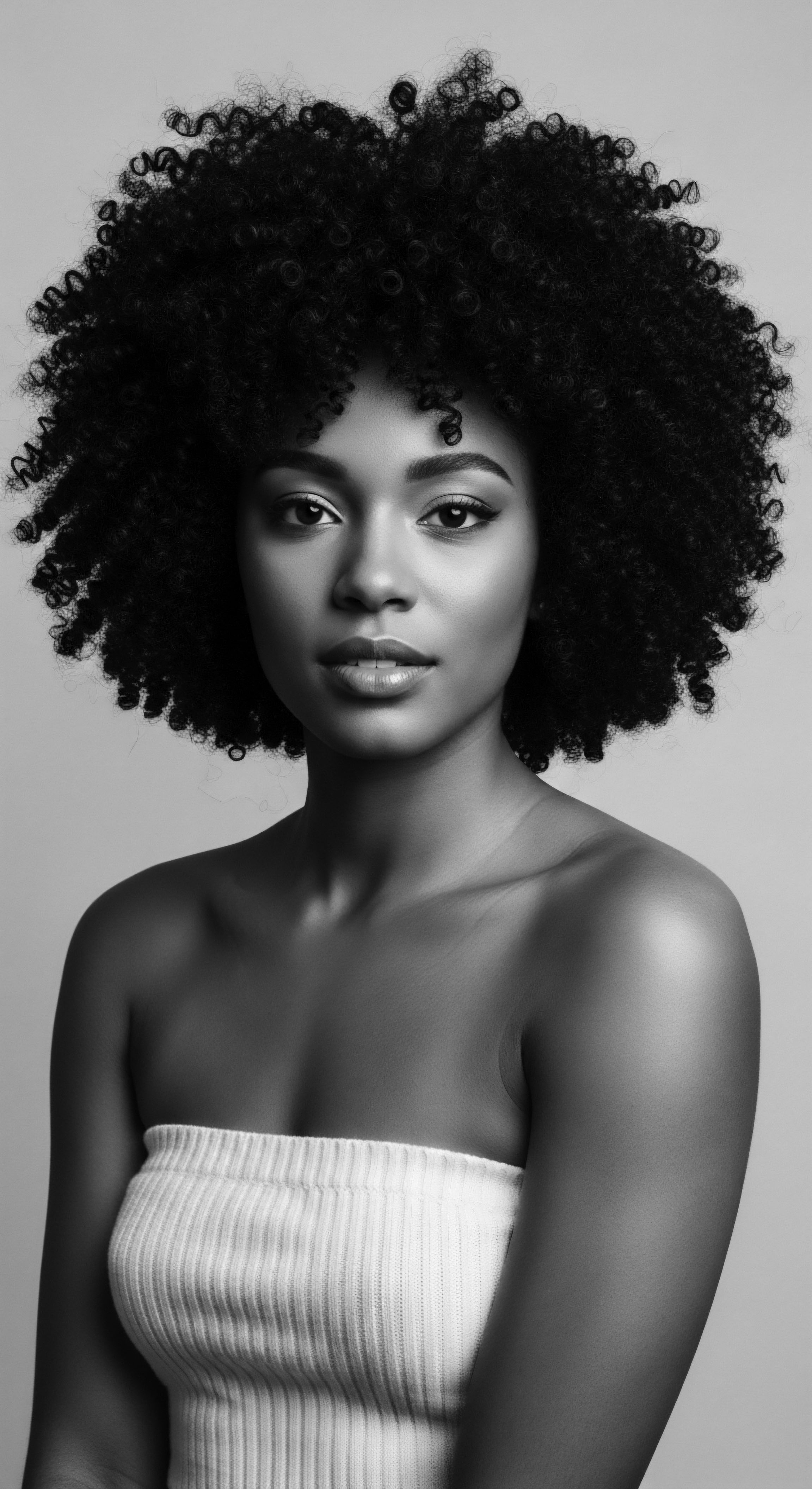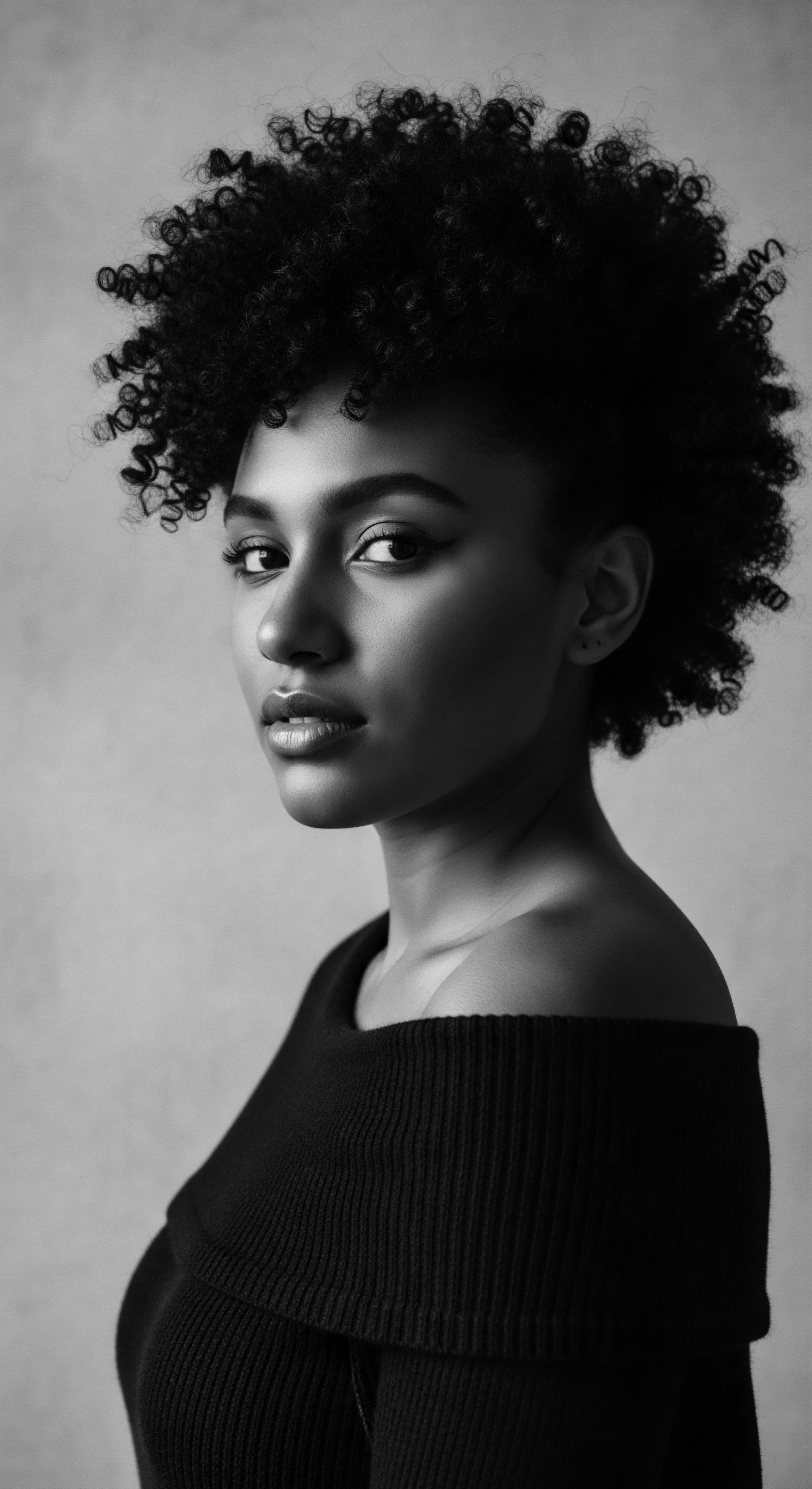
Roots
To stand on solid ground, to feel the profound resonance of identity, one must first recognize the deep soil from which their being springs. For those whose hair coils with the memory of millennia, a living archive stretches back through time, echoing the wisdom of ancestors. How can modern practices honor textured hair heritage from ancient wisdom?
It is a question that invites us not to merely look back, but to perceive the unbroken lineage of care, symbolism, and science woven into every strand. This journey begins not with a contemporary trend, but with the very genesis of textured hair itself, understanding its biological blueprints and the reverence it commanded in civilizations long past.
The earliest chronicles of human adornment consistently feature hair as a central element, a testament to its significance across cultures. For people of African descent, hair held a particularly sacred status, a visible manifestation of lineage, spirit, and community. Consider the artistry of pre-colonial African societies, where hairstyles were rarely arbitrary choices. They served as intricate systems of communication, conveying a person’s Social Status, Age, Marital Standing, Ethnic Identity, Religious Beliefs, and even their Wealth.
The Yoruba people of Nigeria, for instance, regarded the hair as the most elevated part of the body, a conduit for spiritual energy connecting individuals to ancestors and deities. The very act of styling hair, often a communal endeavor, was a ritual in itself, a moment for bonding and the intergenerational transfer of knowledge.
Textured hair, deeply intertwined with ancient wisdom, served as a profound marker of identity and spiritual connection across early African civilizations.

Hair Anatomy and Ancestral Understanding
At its core, textured hair possesses a unique biological architecture, distinct from straight hair. Its elliptical follicle shape causes the hair shaft to grow in a highly curved, coiled pattern, leading to its characteristic spring and volume. This natural curvature means textured hair tends to be drier due to the challenges natural oils face in traveling down the coiled strand.
Ancient peoples, without the aid of modern microscopes, nonetheless understood these intrinsic properties through empirical observation and practical experience. They developed care practices that prioritized moisture and protection, creating a legacy of wellness deeply aligned with the hair’s natural inclinations.
From the humid forests of West Africa to the dry expanses of the Sahara, ancestral communities devised ingenious methods to nourish and protect textured hair. Their practices were intimately linked to their environments, leveraging local flora and fauna. These were not random acts, but sophisticated routines passed down through oral tradition, refined over centuries.

Ancient Classifications and Their Cultural Echoes
While modern trichology classifies hair into types (e.g. 4A, 4B, 4C), ancient societies had their own nuanced ways of distinguishing hair textures, often tied to tribal identity and cultural aesthetics. These classifications were less about numerical categories and more about visual recognition and the styles suitable for particular hair types.
- Yoruba Irun Kiko ❉ A thread-wrapping technique using flexible wool, cotton, or rubber threads to tie hair sections into three-dimensional corkscrew patterns, a protective style that stretches hair and retains length.
- Himba Ochre Styles ❉ The Himba tribe in Namibia wore dreadlocked styles coated with a red ochre paste, symbolizing their connection to the earth and their ancestors. This practice was deeply tied to their environment and cultural worldview.
- Kushite Coiled Braids ❉ The Kushites valued tight, coiled braids and headpieces adorned with jewels, feathers, and metals, reflecting both their tribal identity and religious beliefs. This demonstrated their commitment to tradition and cultural pride.
These methods, though differing in form, shared a common thread ❉ a reverence for hair’s inherent qualities and an understanding of how to work with its natural state for both aesthetic and protective purposes. They reflect a knowledge base that transcended mere appearance, connecting hair to broader cosmological and social structures.

Ritual
The rhythmic motion of hands through textured coils, a shared moment of care and conversation, speaks to the enduring legacy of hair rituals. These practices, honed over generations, extend beyond mere aesthetics; they form a living bridge connecting the past to the present, transforming routine into profound ceremony. How can modern practices honor textured hair heritage from ancient wisdom? It is a question that finds an answer in the deliberate, mindful application of knowledge, ensuring that the wisdom of antiquity guides our contemporary methods of care and styling.
Ancient civilizations understood that caring for textured hair demanded specific approaches. Their methods often involved prolonged periods of styling, which became opportunities for social engagement. As enslaved people in the Americas, this communal aspect of hair care became a vital act of survival and cultural preservation.
Even when stripped of their freedom, they found ways to maintain these rituals, braiding patterns that sometimes served as hidden maps for escape routes, or concealing seeds for survival. This demonstrates hair care as an act of resistance, a quiet assertion of identity in the face of dehumanization.

Protective Styling Through Time
Protective styling is a cornerstone of textured hair care, a practice deeply rooted in ancestral wisdom. These styles minimize manipulation, safeguard delicate ends, and promote length retention. The techniques seen today—braids, twists, cornrows, locs—have direct historical precedents spanning thousands of years. Cornrows, for example, have been traced back to 3500 BCE in African cultures, signifying tribe, age, marital status, and social rank.
Goddess braids and box braids also share ancient origins, with box braids from South Africa dating back to 3500 BCE. These were not just functional; they were works of art, often adorned with beads, cowrie shells, or other items that conveyed status or readiness for marriage.
Ancestral hair practices, like protective braiding, were not only functional but also deeply symbolic and communal, acting as vital cultural conduits.
The continuity of these practices, even through forced migration and oppression, speaks to their power and resilience. Modern practitioners, by learning the origins and purposes of these styles, can bring a deeper respect and intentionality to their craft.

The Language of Adornment
Adornments, too, carried significant meaning. In ancient Egypt, intricate braided wigs were often bedazzled with gold, beads, or jewels, symbolizing wealth, religious devotion, and a connection to the divine. The Kushites used jewels, feathers, and metals in their headpieces. This tradition of using natural materials and precious items to embellish hair transcends mere decoration; it is a continuation of a heritage that sees hair as a sacred canvas for self-expression and cultural storytelling.
| Ancient Practice Communal Braiding for social bonding and knowledge transfer (Pre-colonial Africa) |
| Contemporary Parallel Hair salons and natural hair meetups as community hubs, shared styling sessions among family and friends. |
| Ancient Practice Adorning Braids with cowrie shells, beads, gold, feathers to signify status or spirituality (Ancient Egypt, Kush, various African tribes) |
| Contemporary Parallel Using hair jewelry, cuffs, and extensions to express personal style and cultural pride. |
| Ancient Practice Braiding as Communication for hidden maps or tribal identity (Slavery era, Pre-colonial Africa) |
| Contemporary Parallel Hair as a statement of identity, political expression, or belonging within cultural movements. |
| Ancient Practice Irun Kiko (Yoruba threading) for stretching and protection |
| Contemporary Parallel Modern hair stretching techniques (banded, twisted, blow-dried) and protective styles. |
| Ancient Practice The enduring methods and meanings surrounding textured hair reveal a profound continuum from ancient artistry to contemporary expression. |

Heat Styling and Historical Context
The application of heat to textured hair, while common in modern styling, holds a complex historical context. The hot comb, for example, gained prominence in the late 19th and early 20th centuries, offering Black women a way to straighten their hair, often influenced by Eurocentric beauty standards. This tool, while offering new styling options, could also lead to damage if used improperly or excessively.
Understanding this history allows for a more informed approach to heat styling today, prioritizing low heat, heat protectants, and infrequent use to preserve the hair’s natural integrity and health. The goal is to avoid the historical pressures that often necessitated altering natural hair textures, instead empowering individuals to choose heat styling as a versatile option, not a societal requirement.

Relay
The continuous exchange of knowledge, from elder to youth, from tradition to innovation, represents the vibrant relay of textured hair heritage. How can modern practices honor textured hair heritage from ancient wisdom? It demands a conscious effort to synthesize the ancestral with the contemporary, allowing scientific discovery to validate and deepen our reverence for long-standing care philosophies. This is a discourse that moves beyond simple mimicry, seeking instead a profound integration of past insights with present-day understanding.
The modern textured hair care landscape, a multi-million dollar industry, owes a significant debt to the foundational knowledge passed down through generations. This industry, while offering diverse products and tools, also faces the responsibility of genuinely honoring the cultural roots from which many of its innovations spring. This means moving beyond superficial appropriation to truly understanding the principles that guided ancestral practices.

Building Personalized Regimens From Ancestral Wisdom
Creating a personalized textured hair regimen today can draw directly from the holistic approach of ancient care. Ancestral practices often involved a comprehensive understanding of natural ingredients and their properties, applied with consistency and intention.
For instance, historical records and ethnobotanical studies document the widespread use of plant-based ingredients for hair health across Africa. Shea butter, coconut oil, and aloe vera have been staples for moisturizing and protecting hair. Research in Northeastern Ethiopia identified 17 plant species used for hair and skin care, with Ziziphus spina-christi being highly preferred for cleansing and anti-dandruff properties, and Sesamum orientale leaves for cleansing and styling. In Northern Morocco, an ethnobotanical survey identified 42 plant species traditionally used for hair treatment and care, with prominent families including Lamiaceae (e.g.
rosemary, sage) and Rosaceae (e.g. rose). These findings underscore the deep traditional plant knowledge that supported hair health.
A deep understanding of ancestral botanical knowledge reveals a rich array of natural ingredients used for textured hair care, informing modern holistic regimens.
Modern science, in many instances, offers explanations for the efficacy of these traditional remedies. The fatty acids in shea butter provide emollience; the antimicrobial properties of certain plant extracts support scalp health; and the conditioning nature of natural oils aids in moisture retention for coiled strands. When constructing a regimen today, we can integrate this scientific validation with the spiritual and cultural weight of these ancient practices.
This approach centers on understanding the hair’s inherent needs and providing what it requires, rather than imposing external ideals. It involves:
- Mindful Cleansing ❉ Using gentle, sulfate-free cleansers that do not strip natural oils, akin to the historical use of saponin-rich plants.
- Deep Conditioning ❉ Applying nutrient-rich masks and conditioners, reflecting ancient practices of using natural oils and butters for profound nourishment.
- Protective Styling ❉ Opting for styles that shield the hair from environmental stressors and manipulation, a direct continuation of ancient protective techniques.

The Nighttime Sanctuary and Bonnet Wisdom
The ritual of nighttime hair protection is a profound example of ancestral wisdom seamlessly integrated into modern care. African people historically understood the need to protect their hair from tangling, breakage, and moisture loss during sleep. Headwraps, worn for various reasons from social status to spiritual protection, also served a practical purpose in preserving hairstyles and maintaining hair health.
The bonnet, a contemporary staple for many with textured hair, is a direct descendant of these ancient practices. It safeguards curls and coils, reduces friction against rough fabrics like cotton, and helps retain essential moisture. This simple accessory, often taken for granted, is a quiet symbol of a heritage of care that prioritizes preservation. It reflects the understanding that hair, like the self, requires diligent protection, especially during vulnerable states like sleep.

Addressing Hair Concerns With Ancestral and Modern Solutions
Just as ancient communities faced hair and scalp challenges, modern individuals encounter issues like dryness, breakage, or scalp conditions. The wisdom of the past often provides foundational answers, which modern science can then refine.
For example, a common complaint for textured hair is dryness, a property linked to its unique structure. Ancestral solutions focused on consistent oiling and conditioning with natural fats and plant extracts. This contrasts with contemporary approaches that might advocate for less raw oil, focusing instead on water-based hydration and humectants, yet both aim to address the same fundamental need for moisture.
Consider a specific historical example. During the transatlantic slave trade, enslaved Africans were forced to hide their hair, often being given only Sundays for hair care. This led to communal hair sessions where techniques like threading or plaiting were used to achieve defined curls, protecting the hair and allowing styles to last for days or weeks. This ingenuity, born of necessity, highlights the resilience and adaptability of traditional practices.
It also reveals the profound understanding of hair preservation even in the most challenging circumstances. This historical context illuminates the importance of protective styling as a tool for endurance and identity preservation, which remains relevant today.

Reflection
To truly honor textured hair heritage is to acknowledge its vibrant, living pulse, a rhythm born in ancient lands and persisting through every twist and coil. It is not a static relic but a dynamic force, continually shaping identity and community. The journey from elemental biology to the nuanced artistry of modern care becomes a meditation on the ‘Soul of a Strand’ – recognizing that within each curl lies a story, a memory, and a promise.
Our contemporary practices, when infused with ancestral wisdom, cease to be mere routines; they transform into acts of reverence. By understanding the intricate systems of communication woven into ancient hairstyles, the profound communal bonds forged through shared grooming rituals, and the deep ethnobotanical knowledge that guided our forebears, we do more than care for hair. We tend to a legacy.
We recognize that resilience, beauty, and identity are not separable concepts but rather harmonious aspects of a continuous, sacred inheritance. This living archive, expressed in every conscious choice we make about textured hair, ensures that the whispers of ancient wisdom resound clearly in the present, guiding us toward futures where every strand speaks volumes of its enduring, luminous past.

References
- Afriklens. (2024). African Hairstyles ❉ Cultural Significance and Legacy.
- Expedition Subsahara. (2024). Braids ❉ A Brief Cultural History.
- BLAM UK CIC. (2022). The History Of Black Hair.
- Genesis Career College. (2023). History of Braids ❉ More Than Just a Hairstyle.
- Odele Beauty. (2024). A History Lesson On Hair Braiding.
- AfrikaIsWoke.com. (2023). Pre-Colonial African Hairstyles.
- Roseborough, I. E. & McMichael, A. J. (2009). Hair Care Practices in African-American Patients. Seminars in Cutaneous Medicine and Surgery, 28, 103–108.
- Patil, A. (2023). What Every Dermatologist Must Know About the History of Black Hair.
- Assendelft. (2023). Pre-Colonial African Hairstyles ❉ A Journey Through Time and Culture.
- Hair Care Practices in Women of African Descent. DermNet.
- Akanmori, M. (2015). Hair styling and the significance attached to this practice.
- Mouchane, M. Taybi, H. Gouitaa, N. & Assem, N. (2023). Ethnobotanical Survey of Medicinal Plants used in the Treatment and Care of Hair in Karia ba Mohamed (Northern Morocco). Journal of Medicinal Plants and By-products, 13(1), 201-208.
- Tadesse, W. & Mesfin, T. (2010). Ethnobotany of medicinal plants in Ethiopia. Journal of Ethnopharmacology.
- Bayeh, Y. Mekonnen, H. & Abegaz, B. (2025). Plants used for hair and skin health care by local communities of Afar, Northeastern Ethiopia. Ethnobotany Research and Applications.
- Adekola Ogunbiyi, N. A. E. (2021). African Black Soap ❉ Physicochemical, Phytochemical Properties and Uses. Wiley Online Library.
